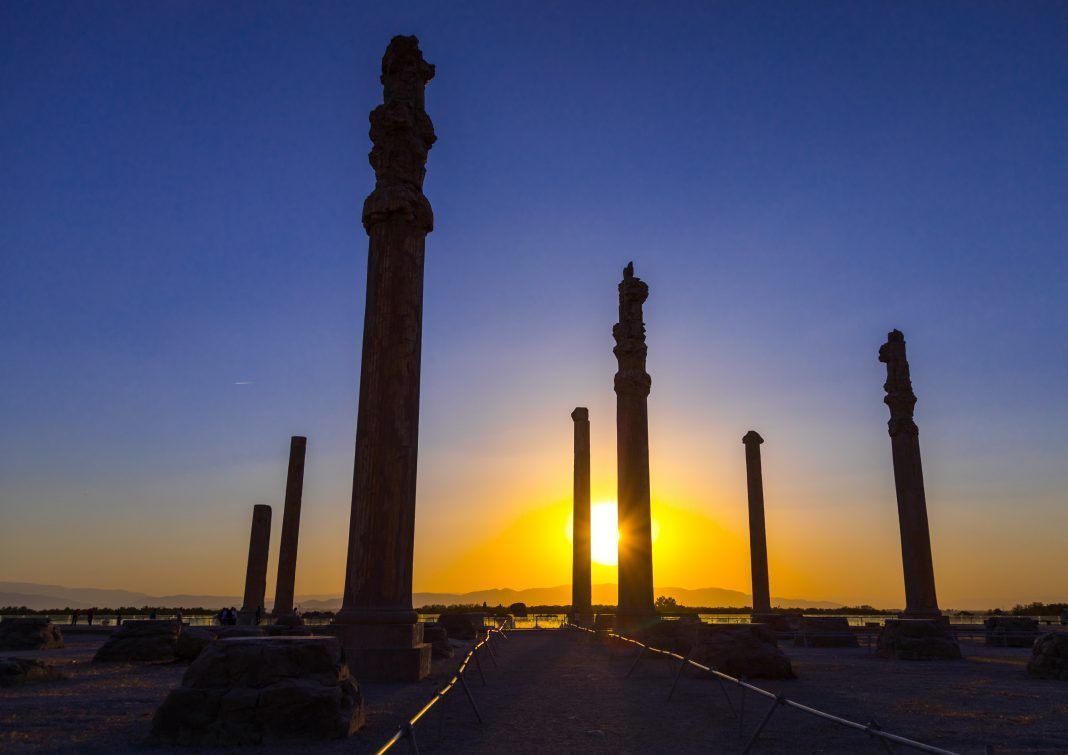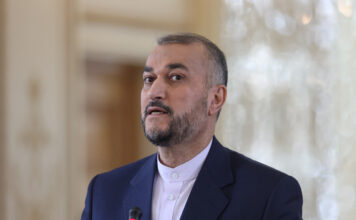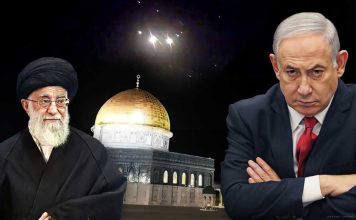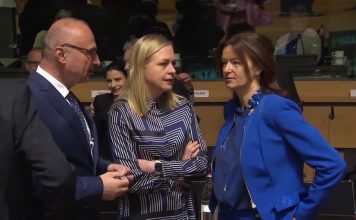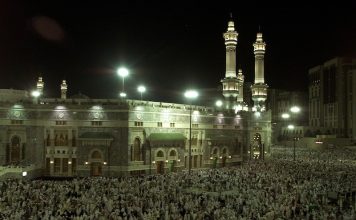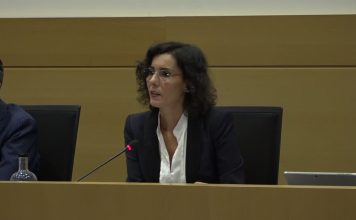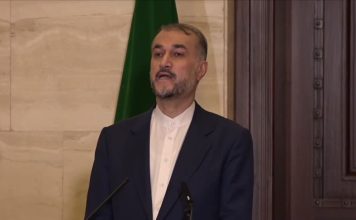By Cyrus Kadivar
In October 1971, Mohammad Reza Pahlavi, the Shah of Iran, held a celebration to commemorate the 2,500th anniversary of the founding of the Persian Empire by Cyrus the Great.
The event was a spectacular piece of political theater and the Shah was center stage. He was presented to Iran and the world as a great king, at once traditional and modern; heir and defender of an ancient Persian monarchical tradition; and modernizing Iranian revolutionary.
In a new book – The Shah’s Imperial Celebrations of 1971: Nationalism, Culture and Politics in Late Pahlavi Iran — Robert Steele, a researcher in Modern Iranian History at UCLA’s Department of Near Eastern Languages and Cultures, disconnects these celebrations from the narrative of the revolution, and views them in the context of the Shah’s rise rather than fall. The book (published by I.B. Tauris) also questions what the regime aimed to achieve by holding the event.
[aesop_image img=”https://kayhanlife.com/wp-content/uploads/2020/10/kadivar-1.jpg” panorama=”off” credit=”KAYHAN LIFE” align=”center” lightbox=”on” captionsrc=”custom” captionposition=”left” revealfx=”off” overlay_revealfx=”off”]
Cyrus Kadivar (author of Farewell Shiraz: An Iranian Memoir of Revolution and Exile) caught up with Steele to find out more about his take on the Persepolis celebrations.
Your book is an in-depth study of the 1971 celebrations of 2,500 years of Iranian monarchy by Mohammad Reza Shah Pahlavi. What inspired you, a British academic, to research, write and publish such a book?
Having studied ancient history as an undergraduate, I became interested in how the ancient past can be appropriated to serve contemporary political narratives. I actually wrote my undergraduate dissertation on Cyrus the Great, so I found the glorification of the pre-Islamic past in the Pahlavi period to be a fascinating case study through which to explore this. And the 2,500th anniversary celebrations were its most grandiose expression.
When I started researching these celebrations, I found that even though they are often said to be a key event in late Pahlavi history, there is very little scholarly literature on them. Scholars tend to dismiss them as a mistake, or a waste of money, often without citing any primary sources or analyzing the event properly. So this was an opportunity for me to tread new ground, dig into the archives and discover sources that can offer new perspectives on this event, and to attempt an objective analysis of its aims and outcomes.
[aesop_image img=”https://kayhanlife.com/wp-content/uploads/2020/10/kadivar-2.jpg” panorama=”off” credit=”Robert Steele” align=”center” lightbox=”on” captionsrc=”custom” captionposition=”left” revealfx=”off” overlay_revealfx=”off”]
What were the sources you accessed?
I used many sources in the research for the book, including newspapers; material from archives in Austria, Britain, France and the Netherlands; published archival materials from Iran and the United States, including those published by the center for historical documents in Tehran; published interviews and memoirs; personal communication with people who attended the celebrations; and official publications, including programs and books. One of the most valuable sources was the archive of Shojaeddin Shafa, held at the Bibliothèque Universitaire des Langues et Civilisations in Paris.
Almost half a century has passed since the event. Why do you think it is relevant today?
This event is still relevant because it is an iconic moment in the history of modern Iran. When you think of the Shah’s rule and his downfall, the celebrations always loom large. People are still fascinated by the event – see the BBC documentary Decadence and Downfall of a few years ago and the discussions it generated.
There are very strong prevailing narratives surrounding the celebrations. In the Islamic Republic, they are referred to as bazm-e ahriman (the devil’s feast), and some believe they were so decadent and outrageous that they can be directly linked to the 1979 revolution. These narratives are never questioned, but the evidence for them has also not been seriously examined before. I believe it’s important to question what the organizers of the celebrations sought to achieve, examine the evidence to determine the extent to which these goals were accomplished, and judge the success or failure of the celebrations in that way, rather than by repeating decades-old arguments and cliches.
Looking back, what was the Shah’s motive to launch such an extravaganza at the ancient ruins of Pasargadae and Persepolis?
I don’t think the Shah was, strictly speaking, motivated at all to host the event. Not initially, at least. The celebrations were actually conceived by the Shah’s cultural counsellor at the Imperial Court, Shojaeddin Shafa, in 1958, primarily as a cultural event. According to early plans, there was to be a ceremony at Pasargadae where the tomb of Cyrus the Great is located, and the main event would be an archaeology congress. There was some talk of inviting foreign heads of state, but this only became a serious idea by the end of the 1960s.
The celebrations are a good example of a project, the conception and design of which are often ascribed to the Shah personally, but in which he really had very little personal input –- though of course he was the central figure during the event itself. He was not involved in the organizing committees and did not write his speeches himself.
The goals of the celebrations were multifaceted. The purpose of inviting the heads of state was to announce Iran’s arrival on the global stage as a rapidly rising industrial and military power to be taken seriously. Iran was prospering largely due to increasing oil revenues, and had begun to take on a leadership role in the Persian Gulf region.
The number of royals, heads of state and their representatives who travelled to Iran is well documented. This ‘diplomatic’ aspect of the celebrations fell short of the Shah’s expectations, especially when the likes of President Richard Nixon of the United States, President Georges Pompidou of France and Queen Elizabeth II of Britain declined their invitations. These rejections are often used as evidence that the Shah and the celebrations weren’t taken particularly seriously by the global elite. One article published in Newsweek, for instance, read that the Shah “invited virtually everybody who was anybody – but mostly nobodies showed up.”
In my book, I argue that the presence of heads of state from countries of the Global South and Eastern Europe, those cynically referred to as “nobodies” by Newsweek, was as important to Iran’s foreign policy goals, if not more so, than the representation of the United States and Western European countries, with which Iran already had long-established relationships. Moreover, by examining diplomatic records of countries such as the United States, Britain and the Netherlands, we see that, although they declined to send their heads of state to the main ceremonies in Iran, they made sure to contribute in other ways. In other words, it is incorrect to say that the Shah or the celebrations were ignored by these states, or that their failure to attend (aside from perhaps President Pompidou’s), should be considered to have been a ‘snub’.
In addition, the Shah’s regime sought to increase awareness of Iranian culture around the world, which was in line with Shafa’s longer-term cultural policy objectives at the Imperial Court. One of the organizers, Abdolreza Ansari, stated, for example, that when he joined the organizing committee towards the end of 1970, the explicit goal was to bring about “the reawakening of the history, civilisation and culture of Iran and creating awareness among the peoples of the world.”
The Shah’s regime also sought to connect itself explicitly to Cyrus the Great –- to give the young Pahlavi monarchy an ancient lineage and thereby increased legitimacy. The focus on the Achaemenids and Cyrus the Great also delivered the message to the world that Iran had a history that was at least as civilized, ancient, and glorious as that of Western Europe.
The Persepolis ceremonies received mixed reviews at home and abroad. Were the criticisms justified?
Many of the criticisms were justified. A lot of money was spent, the celebrations promoted a national discourse that was seen as hubristic and denigrating to Islam, there was a police crackdown in the months prior, and ordinary Iranians were absent from some of the main events. Documents show that the security services were aware of such criticisms in the months leading up to the celebrations, but the regime did little to either alleviate these concerns or put out a strong counternarrative.
For example, Iran’s security and intelligence organization, SAVAK, knew that many people were upset about the cost of the event and that speculation about how much had been spent in total was rife, but the newspapers kept publishing articles detailing the vast sums spent on, for instance, festive lighting in Tehran.
Because the regime never set the record straight, or in any case did not do so convincingly — for example, Court Minister Asadollah Alam held a press conference soon after the event in which he stated the cost to have been $16.8 million — you still see numbers sometimes in the billions of dollars quoted for the cost of the celebrations. In reality, the costs were much lower, and much of the money attributed to the celebrations was spent on infrastructure, amenities and other long-term investments.
A few years ago, BBC 4 aired a documentary entitled Decadence and Downfall: The Shah’s Ultimate Party. What was your reaction to this program?
The documentary was fantastic in many ways – the footage of the celebrations was wonderful and it was exciting to watch. My main problem was that the tone was too sensationalist. For instance, it opens with the caption: “In 1971, the Shah of Iran threw a party at Persepolis, the ancient capital of the Persian Empire. It paved the way for the downfall of the Shah and ushered in an era of Islamic revolutions.”
Elsewhere, waiters and chefs gossip about the cost – one said, for example, that the three-day event at Persepolis cost the equivalent of the entire annual budget of Switzerland. How could he possibly know? Another of the catering staff talks about 50,000 European songbirds having been imported to Persepolis for the occasion, which all died of thirst. This story appears to have been entirely fabricated, because I have never found any evidence for it. I think the statements of these interviewees could have been challenged a bit more.
What was the role of Empress Farah in the organization of the celebrations? Who were the key Iranians behind the actual project?
Empress Farah served as Honorary Chair of the Executive Committee, which was set up in 1970. She chaired meetings every two weeks. The rest of the committee was made up of Asadollah Alam, Abdolreza Ansari, Mehrdad Pahlbod, Mehdi Bushehri, Hormoz Qarib, Shojaeddin Shafa, Cyrus Farzaneh and Amir Mottaqi. Others were closely involved with the group, such as General Nematollah Nasiri, who was in charge of security. These were the main people who made the final arrangements, but over the years many ministries and government agencies were involved in some way or another.
During the Celebrations, Empress Farah was particularly involved in promoting traditional Iranian arts and culture. On the night after the much-maligned gala dinner, the guests were invited to an informal dinner which Empress Farah described as “designed to show everyone the cultural richness of Iran, beginning with its cuisine and its crafts.” The Empress had been involved in this dinner’s organization, and it featured Persian food, Iranian music and traditional dancing.
Shojaeddin Shafa was involved in the celebrations from the very beginning, so I consider him to be the most important figure. He got the support of UNESCO very early on. He was also the head of a separate committee of international affairs, to ensure that events were organized in conjunction with the Celebrations in countries around the world, and from the early 1960s, many countries set up their own ‘Cyrus the Great Committees’.
Another key figure in the organization of the celebrations was Abdolreza Ansari. He had been in charge of Princess Ashraf’s charity foundations and was asked to serve as deputy head of the organizing committee, but since the head, Mehdi Bushehri, was busy leading the Maison de l’Iran in Paris, Ansari was effectively in charge.
Some critics have often attacked the event for its cost, the extensive French menu, the lavish display of clothes and uniforms, the high-level security measures, and the building of a tent city in a remote desert situated miles away from the city of Shiraz. How was this project funded and what was the bill at the end of the day?
It’s hard to say, because there really is no ‘bill.’ The closest thing we have are the final accounts of the organizing council, which show that they spent $24 million, around $18 million of which was provided by the Imperial Court. Documents show that ministries were discouraged from asking the organizing council for money and were instead told that any money they needed to spend on the celebrations should come from their own budgets. So money spent came from many different sources, and it is unclear whether or not there was ever an attempt to put together a total bill at the end. I think it is unlikely.
What we do know is that at least $6 million was provided by the private sector as donations, though the real figure is probably a lot higher. The British ambassador suggests in his report of the celebrations that even British banks contributed something to the event. I couldn’t say how much was spent on the actual ceremonies themselves, not including investments in infrastructure (including, for example, the construction of hotels and a new road from Shiraz to Persepolis), which were largely covered by the Plan Organization, but figures upwards of $100 million are gross exaggerations.
Can you cite the positive and negative impacts of the Shah’s ‘Ultimate Party’?
I think the main positive impacts were cultural and economic. All around the world, exhibitions were held on aspects of Iranian culture and civilization, books were published, and academic conferences organized. At the time of the celebrations, a conference was held at Pahlavi University in Shiraz, attended by around 250 of the leading Iran scholars in the world. In terms of encouraging interest in and scholarship on Iran, the celebrations were very positive.
Economically too, particularly in the context of tourism, the celebrations generated long-term benefits. This was not a convenient by-product of the event either – the head of the tourist organization, Cyrus Farzaneh, served on the organizing committee, and tourism reports were published at the time which detailed the expected impact of the celebrations on the industry. In 1970, 300,000 tourists visited Iran, generating $43 million in foreign currency earnings, but this increased to 415,000 tourists by 1972, and 690,550 by 1977, generating $152 million. On the tourism sector alone, the celebrations had a demonstrable impact.
The negative impacts of the celebrations are very well documented. The event bolstered the narrative of the megalomaniac Shah and the decadence of the Pahlavi court, and the perception that the regime cared more about impressing foreigners than taking care of its own people. These were valid criticisms, and people’s frustrations only grew stronger as the 1970s progressed. Again, SAVAK reports from the time show that the regime was aware of many of these views, but they did nothing to counter them.
The tight security measures imposed on the event, particularly around Persepolis, which was said by one diplomat to be akin to an “impregnable fortress,” enforced the impression that ordinary Iranians were excluded. There were, in fact, genuine security concerns relayed to the organizers by the diplomatic representatives of foreign heads of state who would be attending – in fact, President Nixon had originally accepted his invitation to attend, but withdrew in part due to these security concerns – and the security services foiled several plots by militant groups to disrupt the celebrations.
Nonetheless, though the security measures can be understood, the crackdown on largely peaceful protests on university campuses in the months prior to the celebrations and the arrests of hundreds of potential troublemakers were excessive, and thus served, in the words of Abbas Milani, as a “propaganda bonanza” for opposition groups such as the Confederation of Iranian Students.
How do you hope your book will be received and what does it add to our knowledge of Pahlavi Iran?
I hope it will encourage people to think in new ways about the Pahlavi period, to look more critically at established narratives and to form a more nuanced picture of not just the celebrations, but the period as a whole. The celebrations were a massive undertaking, and they were neither a complete success nor an abject failure. We can point out the positive consequences of the event while acknowledging the mistakes made during their organization.

